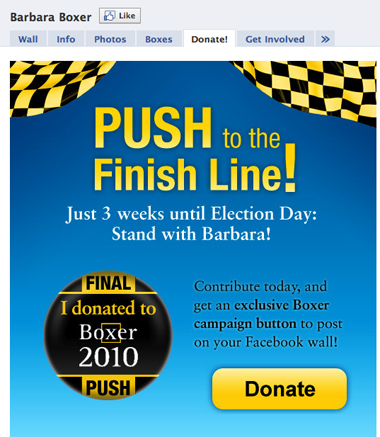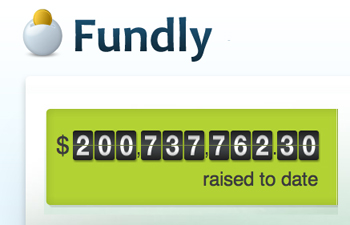Political campaigns and non-profits must constantly “feed the beast” with their fundraising efforts. While traditionally that chore has meant going after people with the most money, the Internet has helped spawn networked fundraising and even “social fundraising” efforts where micro-donations add up to a lot more. According to the Campaign Finance Institute, 53% of the $750 million Barack Obama raised in donations in the 2008 elecition came from small and mid-sized donors who gave less than $1,000.
So it’s not surprising that in the 2010 midterm elections, more candidates were paying attention to online donations. One startup that’s trying to capture the heat of micro-donations and make them more social is Fundly, which started life as BlueSwarm in 2009 before moving to Palo Alto, Calif., from Boston. The donation platform lets candidates begin taking micro-donations online quickly, and even embed those efforts into Facebook. There’s even a customizable button that supporters can use to convince their friends on social networks to give, too.

I spoke to Fundly CEO Dave Boyce recently, who explained how important Facebook and social networks have become for political campaigns — beyond just raising money.
“We have patent pending technology that is a multi-level fundraising application that allows friends to recruit friends, and those friends recruit friends,” Boyce told me. “It helps people become part of a volunteer force that is supporting [a cause or candidate]. If I’m a student and I can afford to write a check for $50, $20, $10, that’s one thing, but I also have a lot of time and energy that I can spend. So if I can find 20 other friends or reach out to a parent or community leader, my overall impact could be $1,500. I wrote a check for $50 but I did some work, making calls from my dorm room. I can compare my overall impact with other people.”

While Fundly only has nine full time staffers and three part-time staffers (and just $800,000 in seed funding), it has already made an impact in the 2010 election cycle, helping Sen. Barbara Boxer (D-Calif.) raise money via Facebook, and aiding the National Replican Congressional Committee in its “39 Seats in 39 Days” pledge drive. And speaking of pledge drives, Boyce believes that non-profit media startups and even public media outlets could benefit from the Fundly platform, which has already helped politicians and non-profits raise more than $200 million. Here are some pertinent stats provided by Fundly:
> Amount raised via Fundly for 2010 midterm elections: $89 million.
> Number of groups/candidates who have used Fundly to run fundraising campaigns: Political organizations: 120. Total customers: 200.
> Highest amount raised with Fundly: Meg Whitman: $30 million.
> Total number of donors that have contributed via Fundly: 260,000
The following is an edited transcript of our phone chat, with Boyce talking about various success stories on Fundly, how they stack up to rivals in fees, and his efforts in raising funds for Fundly itself.
Q&A
What was the impetus for Fundly? Why start it?
Dave Boyce: In politics, there was a fundamental shift in fundraising, with less dependence on high dollar givers, and leveraging technology to get larger numbers of smaller dollar givers, which can add up. Starting way back with Howard Dean [in 2004], to 2008 when Obama and Romney used the strategy to get large numbers of small dollar givers, and use social media and networking and grassroots support, aided by technology to collect all that. It was clearly a trend. And when I joined with them, they had built a platform to facilitate social fundraising and had 20 customers, and the sales cycle was 10 days long. Coming from Oracle where the sales cycle was 10 months, I was pretty intrigued. We have almost 200 customers now. It’s not just a political phenomenon.
Boyce talks about what he wants newly hired engineers to do for Fundly, developing more social applications:
When you work with political campaigns, what was the biggest obstacle you ran into with them?
Boyce: Well they either had religion or they didn’t. Luckily we could take that obstacle right in the beginning. If they wanted to do it the old way, we weren’t a good fit. The old way is using the old boy network and pass the hat, do it very manually. Literally use paper and telephones, and write down pledges, and collect checks and bundle them up in envelopes and hand them to candidates. And a lot of people still fund their entire campaign that way. But if someone had religion, we got pretty far out into Facebook and very clever money bombs and conversion of casual givers into fundraisers themselves. It depends how progressive the people running the campaigns would be.
Were there any campaigns that were innovative in the way they used your platform?
Boyce: Yeah. Barbara Boxer was innovative in the way they used Facebook. We had a few people who did this, but they pushed our thinking on this. You could make a donation inside of Facebook, you didn’t have to leave the Facebook environment. Once you made the donation you were offered a button to put on your wall that indicated you made a donation. And it was tied into a final push campaign. With the average user of Facebook having 130 friends, we would get more than one click per button post. That would lead to subsequent donations.
So you donate, put a button on your Facebook wall, and other people see that, and they donate. So it’s a way of doing viral donations?
Boyce: That’s right. Not only did they put the button on their wall but there was personalization around it. “I support Barbara Boxer because…” and they could choose an issue from a checklist or they could enter their own. It was a way to personally advocate. Another one that was interesting on the other side of the aisle was the National Republican Congressional Committee. They did a well integrated campaign around “39 Days, 39 Seats,” to win the House of Representatives back. They had Facebook and their website and their money bomb all tied to that message, and they did a button as well using Fundly tools. But every property had the exact same messaging and call to action.
What about your own funding? I read you were trying to raise a $5 million round. Where are you in that?
Boyce: We don’t have anything to announce yet, but I’m standing outside an office where my next meeting is. [laughs]
Boyce explains how traditional venture capitalists have lost their appetite for early startups, leaving that funding to the “super angels”:
In your business plan, where do you see profitability coming? When will that happen?
Boyce: It’s always a function of how fast you want to spend money, as well as how fast you can bring in revenues. We’ve been OK with bringing in revenues. We’re not really trying for profitability. I just brought in another engineer last week, and we’re aggressively hiring right now. I’m doing the thing where you jump off the cliff and assemble the plane on the way down. We did over $1 million in revenues this year, which is great for a startup in its first full year of operation. Almost every day I have meetings with people who say, ‘That is such a good idea, why are we not doing that?’
You charge people 2.9% of what they raise in donations. How does that compare to your competitors?
Boyce: So it’s 2.9% that we take, and credit card companies take about 2.5%, so it’s 5.4% total. We scale that down from there with volume, so it can get down to 0.75%. It compares favorably to other solutions out there. I’ve seen one at 5% total, but that’s the lowest I’ve seen. Most are in the 8% range, and the reason for that is that they are piggy-backing off someone else’s back-end system. So 8% is pretty standard, and we start at 5.4% and go down from there.
Who do you consider your top competition?
Boyce: For PR, we compete with a couple guys making noise. They’re not far along building a business, but Crowdrise got an endorsement from Edward Norton, so they’re using his star power to get a lot of PR. Facebook Causes has been around for a long time. We hear about them a lot but nobody really uses Causes. They’ve helped their causes raise $27 million total to date, and we’ve got almost 10 times that. The real competition is the old world, literally Oracle [databases] or a company called BlackBaud, which literally has a database system that sits at the heart of a lot of fundraising operations and people can’t wait to get off of it.
What about the non-profit news sites that have had foundation grants? Could Fundly help those kinds of content sites raise money?
Boyce: Absolutely. By definition they have an audience and readership that cares about what they do. There are a lot of people in that same spot. They traditionally have grants and know they are running out and need to raise money. If you have readers, they will care if you go away, so the obvious thing to do is tap into the readership, to engage them and have them engage their friends. Annual fundraising is a pretty tough gig, but the best way to approach it is peer-to-peer fundraising. You get people to ask their friends, who then ask their friends. That’s how University of Cal-Berkeley, Harvard, Dartmouth all raise their annual funds. I would think the media outlets could learn a lot from that.
They could use Facebook or embed our widget on their website, and they could also get volunteer fundraising.
Boyce explains how Fundly has a multi-level fundraising application allowing friends to recruit friends, and gives volunteers a tally of their overall fundraising impact:
Have you considered approaching public media about using Fundly? They have pledge drives but maybe this could help them raise funds in new ways?
Boyce: I actually think public media does a great job. It’s annoying but it’s effective. Matching pledges, and urgency behind the drives. We are interested in that, and are in preliminary conversations with one big public radio station in Boston. It’s the perfect place, but we just have to get out of our own way and make the connections and start working that.
Are there any features you’d like to add to your platform?
Boyce: There are all sorts of things. A lot of people are using our platform to do matching donations, but we haven’t built that in, so we want to do that to make it easier. People have built in urgency, which you have to do. Any fundraising campaign has to build in urgency and a deadline or it will fall on its face. We want to build in a fundraising campaign functionality where you have to put a deadline in. We have not built a LinkedIn application yet. We have very rudimentary mobile stuff, and want to push it further.
*****
What do you think about Fundly and how micro-donations have played a role in campaign fundraising? Do you think this kind of platform could help non-profit media sites? Share your thoughts in the comments below.
Mark Glaser is executive editor of MediaShift and Idea Lab. He also writes the bi-weekly OPA Intelligence Report email newsletter for the Online Publishers Association. He lives in San Francisco with his son Julian. You can follow him on Twitter @mediatwit.

